If you’ve ever been to a National Park, chances are you’ve come across signage with the same distinctive lettering. The type, which features rounded edges carved into wood in all caps, has become an icon of the National Parks system.
But it turns out that this text isn’t an actual typeface, as information designer Jeremy Shellhorn discovered when he was working as designer-in-residence at Rocky Mountain National Park in 2013.


The project was part of a class that Shellhorn teaches called Design Outside Studio, where he leads a group of University of Kansas design students into Rocky Mountain National Park for a week and a half each summer. The group camps in the park and does design projects in service of the park rangers.

While the studio is a great way for design students to give back, it’s also helpful for re-energizing them creatively when they’re used to staring at computers all day, according to Shellhorn. “It’s a way to get students off the computer and out of studio,” Shellhorn says. “They can be more creative if they’re not locked into the distractions that ultimately happen when they’re here on campus.”
Since Shellhorn published the typeface in summer 2018, it’s been downloaded by people in all 50 states and in several other countries. Next, he hopes to assign students to create a series of dingbats to go along with the typeface. You can download it here.
Recognize your brand’s excellence by applying to this year’s Brands That Matter Awards before the early-rate deadline, May 3.







